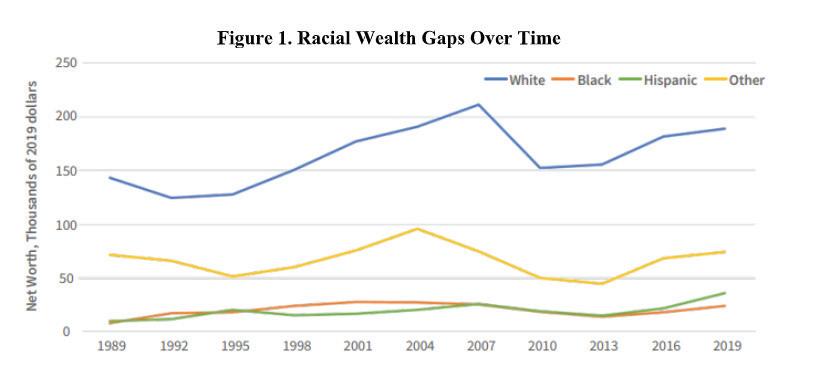
5 minute read
INEQUITIES
FROM PAGE 16 would that be worth today?” ere, he raised Wilson’s father, who was not able to attend college.
Many Black veterans faced issues using the programs o ered by the GI Bill. ey often could not access banks for home loans, were excluded from certain neighborhoods and faced segregationist policies. Instead of a home in the suburbs, and despite his service to his country, Wilson’s grandfather wound up in low-income housing.
“ e only physical thing that I have from (my grandfather) besides his DNA is a collection of hats … that shouldn’t have been the case,” Wilson said. “I should have more from him than his name, his genes and some hats.”
In that era, federal authorities also made color-coded maps that re ected the practice of restricting access to home loans in certain areas, largely based on race. is practice is known as “redlining.” People of color were also excluded from obtaining housing through “racially restrictive covenants,” or text written into property records that was used to prevent people of certain races from purchasing certain homes.
Some exclusionary policies, which have been documented in the Denver area, left a toll that’s evident in communities of color today.
Family wealth is a good measure of that. In 2019, the median White family in the country had about $184,000 in wealth compared to just $38,000 and $23,000 for the median Hispanic and Black families, respectively. at’s according to data from the Federal Reserve Survey of Consumer Finances. ese numbers speak to the notion of generational wealth. Generational wealth is anything of nancial value that is passed from one generation to another — including money, property, investments, valuable heirlooms or businesses.
“ ink about the wealth that was created during (the ‘40s and ‘50s) that White families have been able to leverage generation after generation, either the Colorado rate — many by a large margin, according to U.S. Census Bureau data.
In Cherry Hills Village, a wealthy suburb that borders Denver, the number of Black Americans amounts to 0% of the population. Just a few miles away, the population is 17% Black and 44% White in Aurora, one of Denver’s most diverse suburbs.
Aurora is an exception, not the rule. Many of Denver’s other older suburbs are much less diverse.
Several Adams County cities have large Latino populations, but even though they’re suburban, the cities still tend to have lower-income neighborhoods closer to Denver and more expensive housing farther north.
Still, the suburbs don’t entirely look like they used to, according to Yonah Freemark, senior research associate at the nonpro t Urban Institute, based in Washington, D.C.
“Overall, the suburban parts of the nation have transformed dramatically and have become more diverse over time,” Freemark said. at’s in terms of age, ethnicity and race, and income, Freemark added.

In the future, some suburbs will likely undergo a “steady transformation” toward increased mobility, such as having more public transportation, Freemark said. Other changes could include more e orts to get people walking and biking, with the transition of suburban storefronts and strip malls into more walkable neighborhoods, he added. e path forward for the suburbs may involve a continued increase in diversity of residents, Freemark said. But that depends on whether states and the federal government will expand support and requirements related to a ordable housing, Freemark said.
“We’re going to need signi cant public investment and changes to public law to support those outcomes,” Freemark said. “Otherwise, little is going to change.” e a ordability issue transcends race, with many people simply priced out of the housing market and those who are in it struggling to a ord what they need for their families. In 2010, the median single- family home price in metro Denver was about $200,000. It was roughly triple that as of 2022. to send their kids to college, to be able to start a business, to writing a check for their loved ones to be able to have money for (a) down payment in order to buy their own home and continue that generational wealth transfer,” said Aisha Weeks, managing director at the Dear eld Fund for Black Wealth, a Denver area group that emphasizes homeownership. “ at wasn’t available in mass for Black and African American families.”
Coupled with a ordability is an availability issue that local rules play a role in exacerbating. Large-lot zoning — planning for houses to be built on large portions of land — is one major issue. In other words, there are too many large homes being built and too few starter homes, leaving prospective rst-time homebuyers with few options, perhaps even relegated forever to renting.
“If you have a very expensive largelot neighborhood, you don’t get young families,” Rogers said. “You don’t want your community to box out young families or new Americans. Or, you end up with, in a sense, a retirement community, and there’s nothing wrong with a retirement community, but you don’t want your entire community (to be that). You want kids to be in your schools.” e long-term trend of rising housing prices plays a role, too, as wages fail to keep pace with housing costs. at “has the potential to continue to widen inequality and even perhaps embed it,” Rogers said.
A family’s primary residence is typically their most valuable asset, according to the National Association of Realtors.
It’s not just the monetary value of a house and property that adds to wealth. ere are tax bene ts for homeowners and people can borrow against a home’s equity to start a business or to help with unexpected bills. Homeownership also provides stable housing, which has been shown to positively impact health and educational achievement. ese factors can, in turn, improve a person’s economic prosperity.
Trying to change the equation
e Dear eld Fund for Black Wealth o ers down-payment assistance loans with no interest and no monthly payments up to $40,000 or 15% of the purchase price for Black homebuyers. is program helped Wilson and his wife buy their home in Aurora.

“We acknowledge that there’s a generational wealth gap, and so Dear eld Fund is walking alongside our clients and borrowers to say, ‘We will provide that down-payment assistance,’’’ Weeks said.
In addition, the fund also o ers advice and education on how to build wealth.
“We know that there are so many pitfalls and just things that, as a community, we have not learned at the dinner table like our counterparts,” Weeks said. “ ere’s a lot of power in the knowledge information transfer that happens within other communities that we need to make sure that families are understanding.” at issue of being at the proverbial dinner table comes up a lot for communities of color. Without an example to follow, some rst-time homebuyers don’t know where to begin. According to Alma Vigil, a local loan o cer assistant, families who do not own homes often do not pass along information about how to own and maintain a home.
To address this challenge, the Colorado Housing and Finance Authority o ers homebuyer education programs to teach Coloradans nancial skills and the steps to homeownership. ese classes are o ered in English and Spanish in an e ort to remedy language barriers, which can add challenges for potential homebuyers who do not speak English.
“ ere’s very (few) Spanish speaking loan o cers,” said Vigil, who is Hispanic and speaks Spanish herself. “ ere are some that claim to speak Spanish, but they’re not very uent. So it becomes a huge problem, especially with lack of understanding.” e issue isn’t just one faced by Hispanic and Latino communities. A report by the National Coalition for
In order to close the gaps, some lenders across the metro Denver area provide services in Spanish. A list of Spanish-speaking lenders can be found on the Colorado Housing and Finance Authority’s website.


